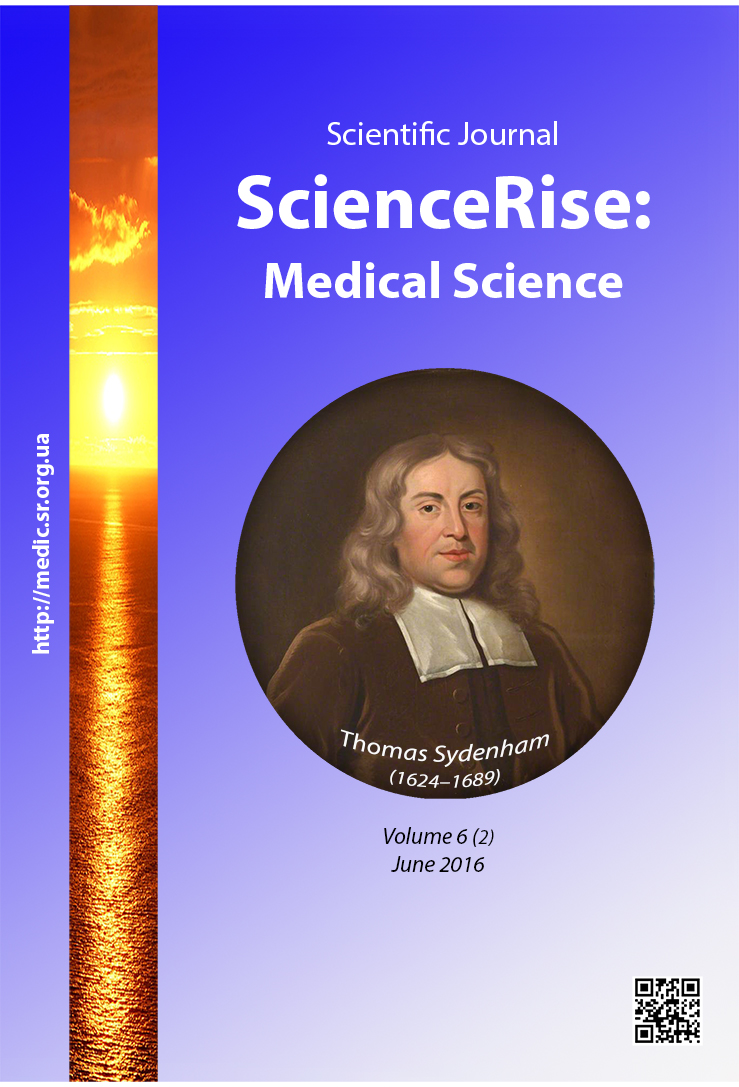Визначення активності факторів зсідання крові у хворих на гіпертонічну хворобу ІІ стадії в поєднанні з ХОЗЛ за допомогою високоспецифічних тестів з отрутами змій
DOI:
https://doi.org/10.15587/2519-4798.2016.72549Ключові слова:
гіпертонічна хвороба, ХОЗЛ, гемостаз, коагуляція, фактори згортання крові, отрута змійАнотація
Метою роботи було визначення особливостей змін плазмового гемостазу за допомогою високоспецифічних отрут змій у хворих на ГХ в поєднанні з ХОЗЛ. В результаті роботи було виявлено схильність до гіпокоагуляції на початку процесів коагуляції, яке поєднується з вираженою активацією кінцевої фази згортання крові у пацієнтів з коморбідним перебігом ГХ і ХОЗЛ
Посилання
- Moiseenko, V. О. (2014). Vegetative homeostasis and violations of hemodynamics in patients with arterial hypertension against the background of kidney damage. Practicuyuchyy Likar, 3, 92–94.
- Byy, М. Z., Lebedeva, А. J., Gordeev, I. G., Volov, N. А., Таratuhin, Е. О. (2013). Communication and heart rate variability parameters of the hemostatic system in patients with coronary heart disease complicated with chronic heart failure. Russian Cardiology Journal, 5, 6–11.
- Siryk, V. О. (2010). Changes in functional activity of platelets and hemostasis system in patients with varying degrees of hypertension. Medicine today and tomorrow, 1, 82–87.
- Strogiy, V. V., Voitovich, Т. N. (2011). Hemostasis in adolescents with arterial hypertension. Pediatrics. Journal named after G. N. Speranskii, 90 (5), 19–24.
- Order number 384 "On approval and introduction of medical and technological documents and standardization of medical care in hypertension." (2012). Ministry of Health of Ukraine.
- Gavrisyuk, V. К. (2009). Systemic manifestations of COP: Clinical Features, diagnosis and of treatment. Ukrainian pulmonological journal, 2, 7.
- Hurst, J. R., Vestbo, J., Anzueto, A. (2010). Susceptibility to exacerbation in chronic obstructive pulmonary disease. N. Engl. J. Med., 363 (12), 1128–1138. doi: 10.1056/nejmoa0909883
- Vestbo, J., Rennard, S. (2010). Chronic Obstructive Pulmonary Disease Biomarker(s) for Disease Activity Needed–Urgently. American Journal of Respiratory and Critical Care Medicine, 182 (7), 863–864. doi: 10.1164/rccm.201004-0602ed
- Marcinkiewicz, C. (2005). Functional Characteristic of Snake Venom Disintegrins: Potential Therapeutic Implication. Current Pharmaceutical Design, 11 (7), 815–827. doi: 10.2174/1381612053381765
- Platonova, T. N., Chernyshenko, T. N., Hornytska, A. V., Savchuk, O. N., Sokolovskaya, L. I., Hamisoniya, M. Sh., Makogonenko, E. M. (2000). Laboratory diagnosis of the state of hemostasis. Ukr. Biochem. Zh., 72 (6), 67–73.
- Karbovskyy, V. L. (2009). Influence of proteins from Agkistrodon blomhofii ussuriensis on human hemostasis system. 34th FEBS Congress. Prague, 372.
- Burlova-Vasileva, M. K., Katra, T. B., Savchuk, A. M., Kravchenko, N., Melnik, V. S., Shandyuk, V. Y. (2014). Chronometric coagulation tests in the assessment for atherothrombotic and cardioembolic ischemic stroke, ischemic stroke on the background of atrial fibrillation. Odessa Medical zhurnal, 3, 45–48.
- Barkagan, Z. S., Momot, A. P. (2001). Diagnosis and therapy controlled hemostasis disorders. Moscow: Nyudiamed, 296.
##submission.downloads##
Опубліковано
Як цитувати
Номер
Розділ
Ліцензія
Авторське право (c) 2016 Світлана Олегівна Самойлова, Ольга Миколаївна Плєнова

Ця робота ліцензується відповідно до Creative Commons Attribution 4.0 International License.
Наше видання використовує положення про авторські права Creative Commons CC BY для журналів відкритого доступу.
Автори, які публікуються у цьому журналі, погоджуються з наступними умовами:
1. Автори залишають за собою право на авторство своєї роботи та передають журналу право першої публікації цієї роботи на умовах ліцензії Creative Commons CC BY, котра дозволяє іншим особам вільно розповсюджувати опубліковану роботу з обов'язковим посиланням на авторів оригінальної роботи та першу публікацію роботи у цьому журналі.
2. Автори мають право укладати самостійні додаткові угоди щодо неексклюзивного розповсюдження роботи у тому вигляді, в якому вона була опублікована цим журналом (наприклад, розміщувати роботу в електронному сховищі установи або публікувати у складі монографії), за умови збереження посилання на першу публікацію роботи у цьому журналі.










